The Role of Heterogeneity on Deformation and Flow in Fractured Coal Slopes
Abstract
1. Introduction
2. Methodology
2.1. Fracture Permeability
2.2. Fracture Distribution
2.3. Mechanical Properties
3. Results and Discussion
3.1. Confinement Effects on the Permeability
3.2. Numerical Simulations on the Fracture Aperture Heterogeneity
4. Conclusions
Author Contributions
Funding
Data Availability Statement
Acknowledgments
Conflicts of Interest
Abbreviations
| MOOSE | Multiphysics Object-Orientated Simulation Environment |
References
- Wang, P.; Jiang, L.; Jiang, J.; Zheng, P.; Li, W. Strata behaviors and rock burst–inducing mechanism under the coupling effect of a hard, thick stratum and a normal fault. Int. J. Geomech. 2018, 18, 04017135. [Google Scholar] [CrossRef]
- Bear, J.; Tsang, C.F.; De Marsily, G. Flow and Contaminant Transport in Fractured Rock; Academic Press: Cambridge, MA, USA, 2012. [Google Scholar]
- Parker, B.L.; Cherry, J.A.; Chapman, S.W. Discrete fracture network approach for studying contamination in fractured rock. AQUA Mundi 2012, 3, 101–116. [Google Scholar]
- Blessent, D.; Jørgensen, P.R.; Therrien, R. Comparing discrete fracture and continuum models to predict contaminant transport in fractured porous media. Groundwater 2014, 52, 84–95. [Google Scholar] [CrossRef] [PubMed]
- Schweiger, H.; Thurner, R.; Pöttler, R. Reliability analysis in geotechnics with deterministic finite elements—Theoretical concepts and practical application. Int. J. Geomech. 2001, 1, 389–413. [Google Scholar] [CrossRef]
- Hsu, S.C.; Nelson, P.P. Material spatial variability and slope stability for weak rock masses. J. Geotech. Geoenviron. Eng. 2006, 132, 183–193. [Google Scholar] [CrossRef]
- Song, K.I.; Cho, G.C.; Lee, S.W. Effects of spatially variable weathered rock properties on tunnel behavior. Probab. Eng. Mech. 2011, 26, 413–426. [Google Scholar] [CrossRef]
- Pandit, B.; Tiwari, G.; Latha, G.M.; Babu, G.S. Stability analysis of a large gold mine open-pit slope using advanced probabilistic method. Rock Mech. Rock Eng. 2018, 51, 2153–2174. [Google Scholar] [CrossRef]
- Merrien-Soukatchoff, V.; Korini, T.; Thoraval, A. Use of an integrated discrete fracture network code for stochastic stability analyses of fractured rock masses. Rock Mech. Rock Eng. 2012, 45, 159–181. [Google Scholar] [CrossRef]
- Grenon, M.; Landry, A.; Hadjigeorgiou, J.; Lajoie, P.L. Discrete fracture network based drift stability at the Éléonore mine. Min. Technol. 2017, 126, 22–33. [Google Scholar] [CrossRef]
- Wang, L.; Chen, W.; Tan, X.; Tan, X.; Yang, J.; Yang, D.; Zhang, X. Numerical investigation on the stability of deforming fractured rocks using discrete fracture networks: A case study of underground excavation. Bull. Eng. Geol. Environ. 2020, 79, 133–151. [Google Scholar] [CrossRef]
- Zhu, G.; Sousa, R.; He, M.; Zhou, P.; Yang, J. Stability analysis of a non-pillar-mining approach using a combination of discrete fracture network and discrete-element method modeling. Rock Mech. Rock Eng. 2020, 53, 269–289. [Google Scholar] [CrossRef]
- Yin, T.; Chen, Q. Simulation-based investigation on the accuracy of discrete fracture network (DFN) representation. Comput. Geotech. 2020, 121, 103487. [Google Scholar] [CrossRef]
- Baek, S.H.; Kim, C.Y.; Kim, K.Y.; Hong, S.W.; Moon, H.K. A numerical study on the effect of heterogeneous/anisotropic nature of rock masses on displacement behavior of tunnel. Tunn. Undergr. Space Technol. 2006, 21, 391. [Google Scholar] [CrossRef]
- Kong, P.; Jiang, L.; Shu, J.; Sainoki, A.; Wang, Q. Effect of fracture heterogeneity on rock mass stability in a highly heterogeneous underground roadway. Rock Mech. Rock Eng. 2019, 52, 4547–4564. [Google Scholar] [CrossRef]
- Sitharam, T.; Sridevi, J.; Shimizu, N. Practical equivalent continuum characterization of jointed rock masses. Int. J. Rock Mech. Min. Sci. 2001, 38, 437–448. [Google Scholar] [CrossRef]
- Gutierrez, M.; Youn, D.J. Effects of fracture distribution and length scale on the equivalent continuum elastic compliance of fractured rock masses. J. Rock Mech. Geotech. Eng. 2015, 7, 626–637. [Google Scholar] [CrossRef]
- Shin, H.; Santamarina, J.C. An implicit joint-continuum model for the hydro-mechanical analysis of fractured rock masses. Int. J. Rock Mech. Min. Sci. 2019, 119, 140–148. [Google Scholar] [CrossRef]
- Shojaei, A.; Taleghani, A.D.; Li, G. A continuum damage failure model for hydraulic fracturing of porous rocks. Int. J. Plast. 2014, 59, 199–212. [Google Scholar] [CrossRef]
- Fernández-Álvarez, J.P.; Álvarez-Álvarez, L.; Díaz-Noriega, R. Groundwater numerical simulation in an open pit mine in a limestone formation using MODFLOW. Mine Water Environ. 2016, 35, 145–155. [Google Scholar] [CrossRef]
- Gui, Y.L.; Bui, H.H.; Kodikara, J.; Zhang, Q.B.; Zhao, J.; Rabczuk, T. Modelling the dynamic failure of brittle rocks using a hybrid continuum-discrete element method with a mixed-mode cohesive fracture model. Int. J. Impact Eng. 2016, 87, 146–155. [Google Scholar] [CrossRef]
- Zhang, H.; Huang, Y.; Yang, Z.; Xu, S.; Chen, X. A discrete-continuum coupled finite element modelling approach for fibre reinforced concrete. Cem. Concr. Res. 2018, 106, 130–143. [Google Scholar] [CrossRef]
- Pruess, K.; Wang, J.; Tsang, Y. On thermohydrologic conditions near high-level nuclear wastes emplaced in partially saturated fractured tuff: 2. Effective continuum approximation. Water Resour. Res. 1990, 26, 1249–1261. [Google Scholar]
- Witherspoon, P.A.; Wang, J.S.; Iwai, K.; Gale, J.E. Validity of cubic law for fluid flow in a deformable rock fracture. Water Resour. Res. 1980, 16, 1016–1024. [Google Scholar] [CrossRef]
- Zimmerman, R.W.; Bodvarsson, G.S. Hydraulic conductivity of rock fractures. Transp. Porous Media 1996, 23, 1–30. [Google Scholar] [CrossRef]
- Waite, M.E.; Ge, S.; Spetzler, H.; Bahr, D.B. The effect of surface geometry on fracture permeability: A case study using a sinusoidal fracture. Geophys. Res. Lett. 1998, 25, 813–816. [Google Scholar] [CrossRef]
- Teng, T.; Gao, F.; Ju, Y.; Xue, Y. How moisture loss affects coal porosity and permeability during gas recovery in wet reservoirs? Int. J. Min. Sci. Technol. 2017, 27, 899–906. [Google Scholar] [CrossRef]
- Wang, K.; Liu, A.; Zhou, A. Theoretical analysis of influencing factors on resistance in the process of gas migration in coal seams. Int. J. Min. Sci. Technol. 2017, 27, 315–319. [Google Scholar] [CrossRef]
- Iwai, K. Fundamental studies of fluid flow through a single fracture. Ph.D. Thesis, University of California, Berkeley, CA, USA, 1976. [Google Scholar]
- Barton, N.; Bandis, S.; Bakhtar, K. Strength, deformation and conductivity coupling of rock joints. Int. J. Rock Mech. Min. Sci. Geomech. Abstr. 1985, 22, 121–140. [Google Scholar]
- Chen, M.; Bai, M.; Roegiers, J.C. Permeability tensors of anisotropic fracture networks. Math. Geol. 1999, 31, 335–373. [Google Scholar] [CrossRef]
- Snow, D.T. Anisotropie permeability of fractured media. Water Resour. Res. 1969, 5, 1273–1289. [Google Scholar] [CrossRef]
- Seidle, J.; Jeansonne, M.; Erickson, D. Application of matchstick geometry to stress dependent permeability in coals. In Proceedings of the SPE Rocky Mountain Regional Meeting, Casper, Wyoming, 18–21 May 1992. [Google Scholar]
- Liu, H.H.; Rutqvist, J. A new coal-permeability model: Internal swelling stress and fracture–matrix interaction. Transp. Porous Media 2010, 82, 157–171. [Google Scholar] [CrossRef]
- Chen, D.; Pan, Z.; Ye, Z. Dependence of gas shale fracture permeability on effective stress and reservoir pressure: Model match and insights. Fuel 2015, 139, 383–392. [Google Scholar] [CrossRef]
- Yan, Z.; Wang, K.; Zang, J.; Wang, C.; Liu, A. Anisotropic coal permeability and its stress sensitivity. Int. J. Min. Sci. Technol. 2019, 29, 507–511. [Google Scholar] [CrossRef]
- Guvanasen, V.; Chan, T. A three-dimensional numerical model for thermohydromechanical deformation with hysteresis in a fractured rock mass. Int. J. Rock Mech. Min. Sci. 2000, 37, 89–106. [Google Scholar] [CrossRef]
- Huo, D.; Benson, S.M. An experimental investigation of stress-dependent permeability and permeability hysteresis behavior in rock fractures. In Fluid Dynamics in Complex Fractured-Porous Systems; Wiley: Amsterdam, The Netherlands, 2015; pp. 99–114. [Google Scholar]
- Selvadurai, A. Normal stress-induced permeability hysteresis of a fracture in a granite cylinder. Geofluids 2015, 15, 37–47. [Google Scholar] [CrossRef]
- Zheng, G.; Pan, Z.; Chen, Z.; Tang, S.; Connell, L.D.; Zhang, S.; Wang, B. Laboratory study of gas permeability and cleat compressibility for CBM/ECBM in Chinese coals. Energy Explor. Exploit. 2012, 30, 451–476. [Google Scholar] [CrossRef]
- Lei, G.; Cao, N.; McPherson, B.J.; Liao, Q.; Chen, W. A novel Analytical Model for pore Volume compressibility of fractal porous Media. Sci. Rep. 2019, 9, 14472. [Google Scholar] [CrossRef]
- Tan, Y.; Pan, Z.; Feng, X.T.; Zhang, D.; Connell, L.D.; Li, S. Laboratory characterisation of fracture compressibility for coal and shale gas reservoir rocks: A review. Int. J. Coal Geol. 2019, 204, 1–17. [Google Scholar] [CrossRef]
- Hu, R.; Walsh, S.; Missen, J.; Anderson, N. Simulating fracture network permeability in brown-coal slopes. In Proceedings of the 2020 International Symposium on Slope Stability in Open Pit Mining and Civil Engineering, Australian Centre for Geomechanics. Crawley, Australia, 12 May 2020; pp. 1281–1290. [Google Scholar]
- Hu, R.; Walsh, S.D. Effective Continuum Approximations for Permeability in Brown-Coal and Other Large-Scale Fractured Media. Geosciences 2021, 11, 511. [Google Scholar] [CrossRef]
- Meng, Z.; Peng, S.; Li, H. Influence of normal faults on the physical and mechanical properties of coal and the distribution of underground pressure. Mei T’an Hsueh Pao (J. China Coal Soc.) 2001, 26, 561–566. [Google Scholar]
- Scholtès, L.; Donzé, F.V.; Khanal, M. Scale effects on strength of geomaterials, case study: Coal. J. Mech. Phys. Solids 2011, 59, 1131–1146. [Google Scholar] [CrossRef]
- Tolooiyan, A.; Mackay, R.; Xue, J. Measurement of the tensile strength of organic soft rock. Geotech. Test. J. 2014, 37, 991–1001. [Google Scholar] [CrossRef]
- Narendranathan, S.; Stipcevich, J.; Rastogi, S. A case study: Assessing the impacts of open cut coal mining on the Maryvale Field (Yallourn) Open Cut and Morwell River Diversion through the use of finite element modelling. In Proceedings of the 2020 International Symposium on Slope Stability in Open Pit Mining and Civil Engineering, Crawley, Australia, 12 May 2020; Australian Centre for Geomechanics: Crawley, Australia, 2020; pp. 849–862. [Google Scholar]
- Lindsay, P.; Campbell, R.; Fergusson, D.; Gillard, G.; Moore, T. Slope stability probability classification, Waikato coal measures, New Zealand. Int. J. Coal Geol. 2001, 45, 127–145. [Google Scholar] [CrossRef]
- Zhao, Z.; Wang, W.; Wang, L.; Dai, C. Compression–shear strength criterion of coal–rock combination model considering interface effect. Tunn. Undergr. Space Technol. 2015, 47, 193–199. [Google Scholar] [CrossRef]
- Barton, C. Regional stress and structure in relation to brown coal open cuts of the Latrobe Valley, Victoria. J. Geol. Soc. Aust. 1981, 28, 333–339. [Google Scholar] [CrossRef]
- Nag, D. Estimation of in situ stress in the Latrobe Valley Coal mines with special reference to Loy Yang Mine, Australia. In Computer Applications in the Mineral Industries; CRC Press: Boca Raton, FL, USA, 2020; pp. 601–606. [Google Scholar]
- Mark, C.; Gadde, M. Global trends in coal mine horizontal stress measurements. In Proceedings of the 10th Underground Coal Operators’ Conference, Wollongong, Australia, 11–12 February 2010; University of Wollongong & the Australasian Institute of Mining and Metallurgy: Wollongong, Australia, 2010; pp. 21–39. [Google Scholar]
- Karatela, E.; Taheri, A.; Xu, C.; Stevenson, G. Study on effect of in situ stress ratio and discontinuities orientation on borehole stability in heavily fractured rocks using discrete element method. J. Pet. Sci. Eng. 2016, 139, 94–103. [Google Scholar] [CrossRef]
- Tonks, M.R.; Gaston, D.; Millett, P.C.; Andrs, D.; Talbot, P. An object-oriented finite element framework for multiphysics phase field simulations. Comput. Mater. Sci. 2012, 51, 20–29. [Google Scholar] [CrossRef]
- Podgorney, R.; Huang, H.; Gaston, D. Massively Parallel Fully Coupled Implicit Modeling of Coupled Thermal-Hydrological-Mechanical Processes for Enhanced Geothermal System Reservoirs; Technical Report; Idaho National Laboratory (INL): Idaho Falls, ID, USA, 2010. [Google Scholar]
- Wilkins, A.; Green, C.P.; Ennis-King, J. PorousFlow: A multiphysics simulation code for coupled problems in porous media. J. Open Source Softw. 2020, 5, 2176. [Google Scholar] [CrossRef]
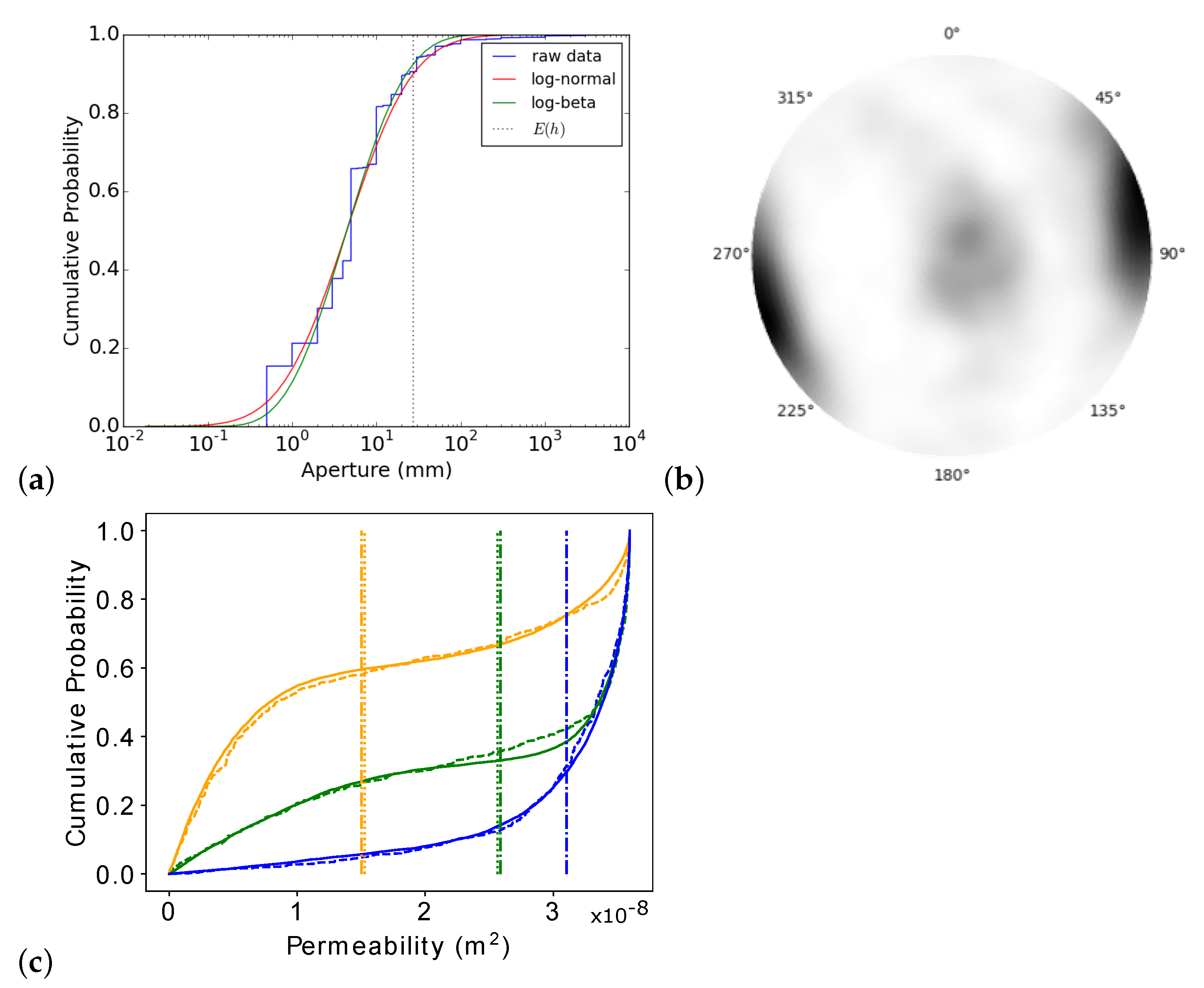
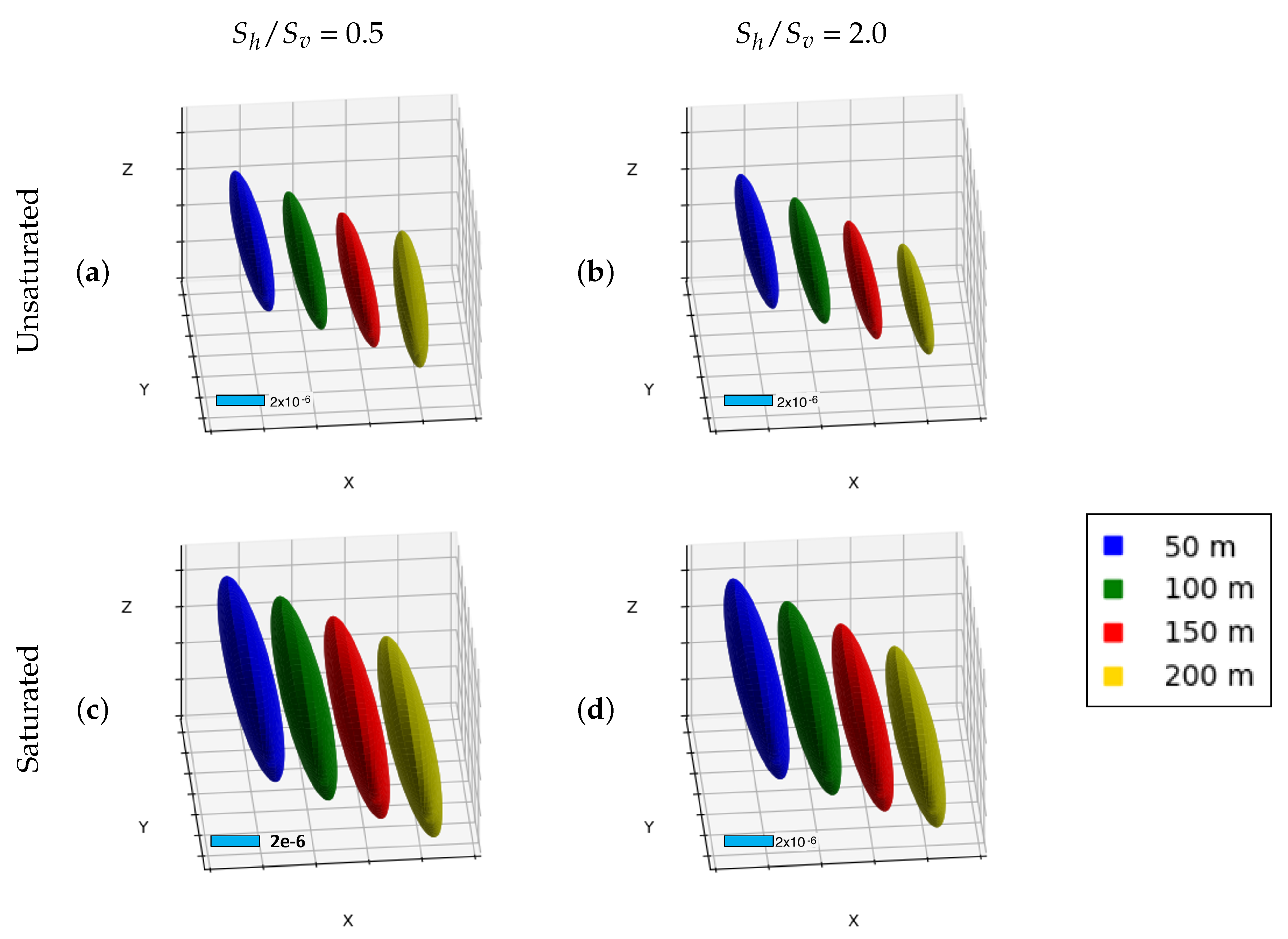
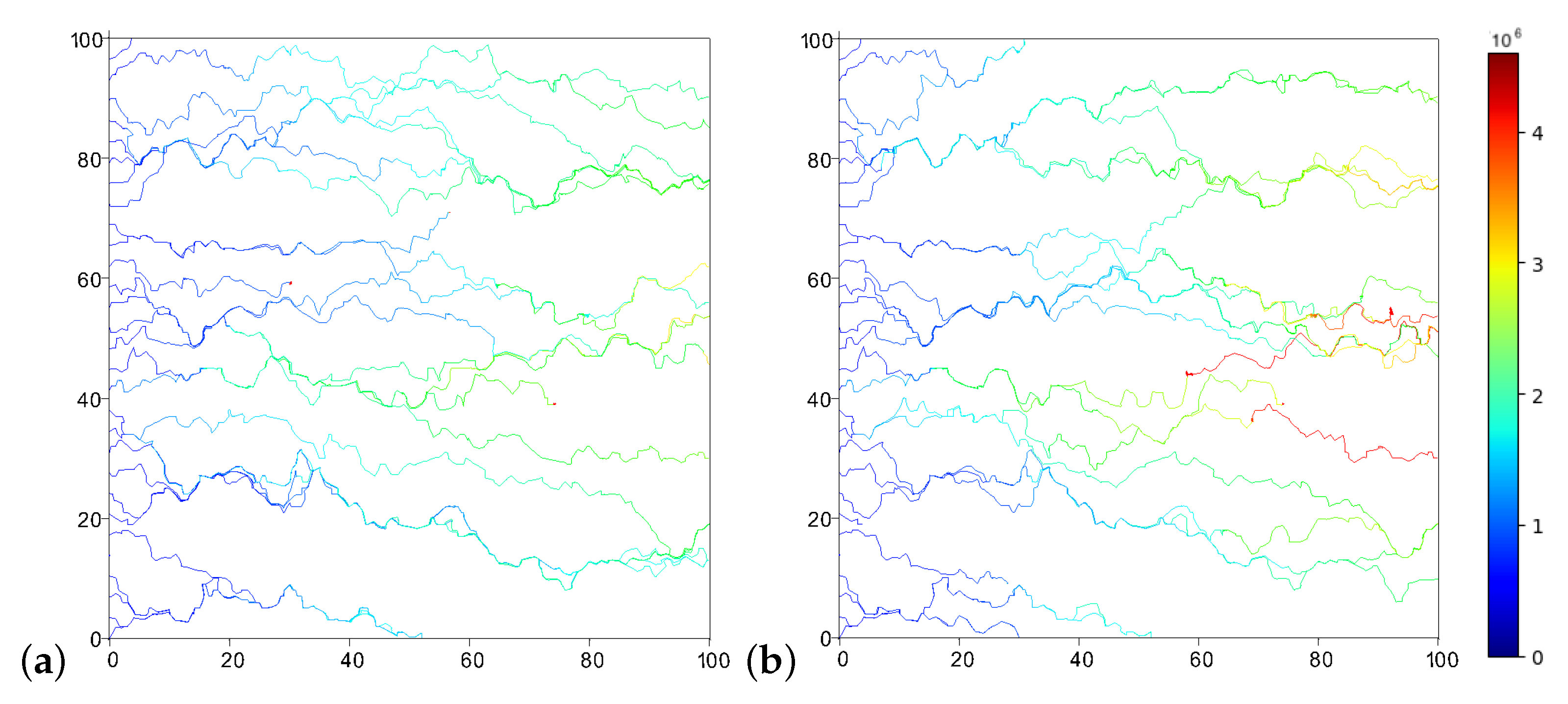

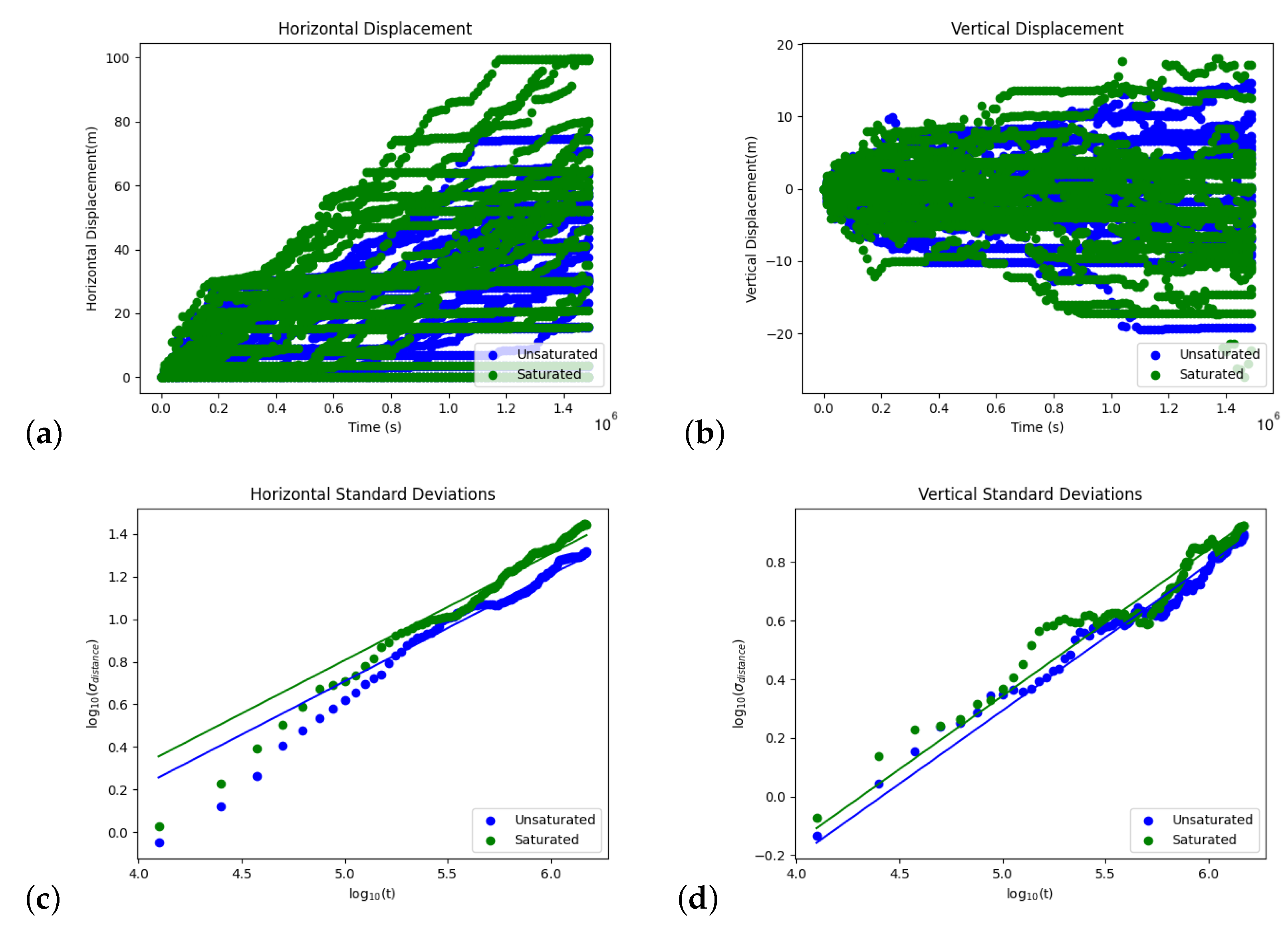
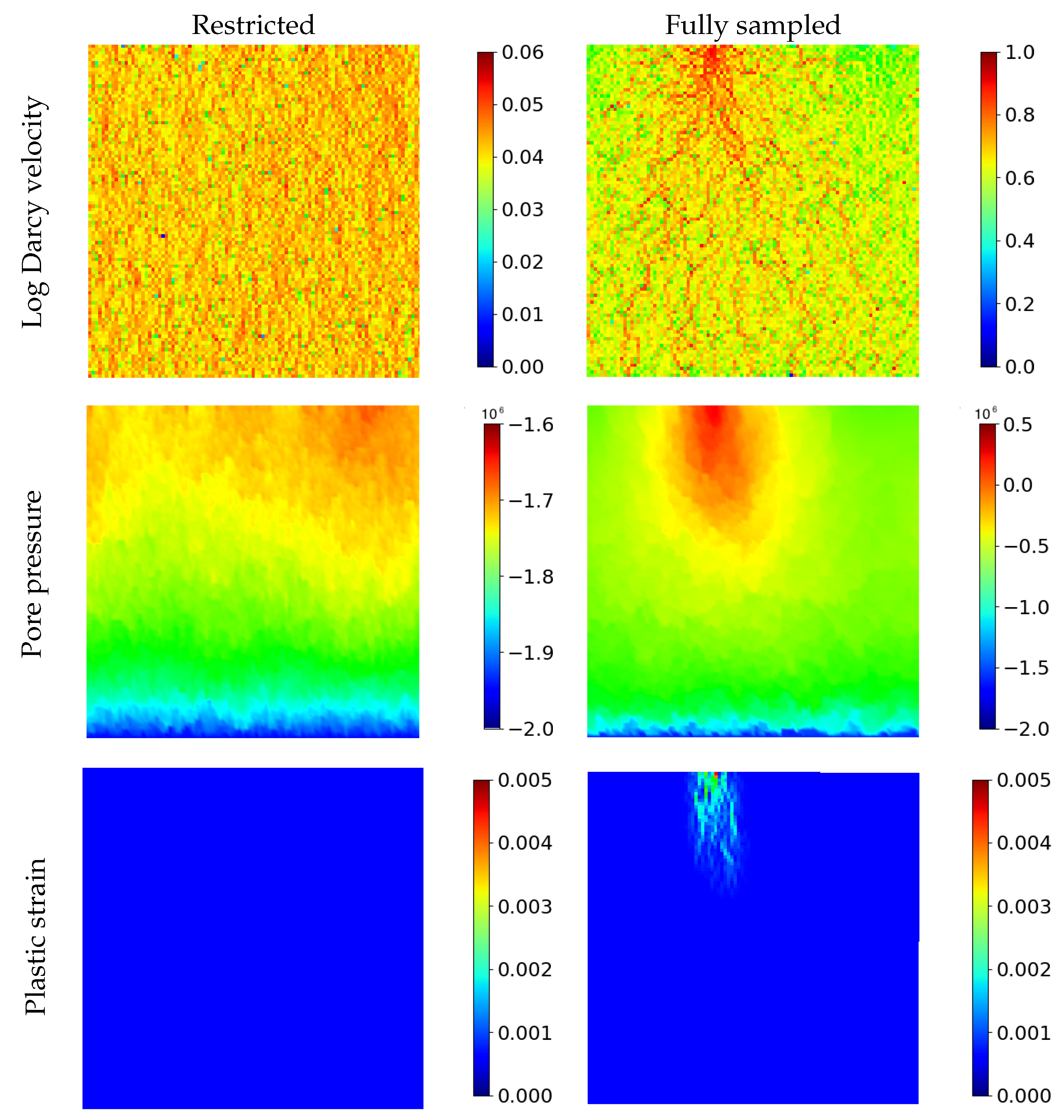
| Unsaturated | Saturated | |
|---|---|---|
| Horizontal Intercept | −1.791 | −1.692 |
| Vertical Intercept | −2.206 | −2.156 |
| Mean Horizontal Velocity (m/s) | 0.000141 | 0.000216 |
| 0.927 | 0.954 | |
| 0.137 | 0.113 |
Publisher’s Note: MDPI stays neutral with regard to jurisdictional claims in published maps and institutional affiliations. |
© 2022 by the authors. Licensee MDPI, Basel, Switzerland. This article is an open access article distributed under the terms and conditions of the Creative Commons Attribution (CC BY) license (https://creativecommons.org/licenses/by/4.0/).
Share and Cite
Hu, R.; Walsh, S.D.C. The Role of Heterogeneity on Deformation and Flow in Fractured Coal Slopes. Minerals 2022, 12, 1297. https://doi.org/10.3390/min12101297
Hu R, Walsh SDC. The Role of Heterogeneity on Deformation and Flow in Fractured Coal Slopes. Minerals. 2022; 12(10):1297. https://doi.org/10.3390/min12101297
Chicago/Turabian StyleHu, Roger, and Stuart D. C. Walsh. 2022. "The Role of Heterogeneity on Deformation and Flow in Fractured Coal Slopes" Minerals 12, no. 10: 1297. https://doi.org/10.3390/min12101297
APA StyleHu, R., & Walsh, S. D. C. (2022). The Role of Heterogeneity on Deformation and Flow in Fractured Coal Slopes. Minerals, 12(10), 1297. https://doi.org/10.3390/min12101297





